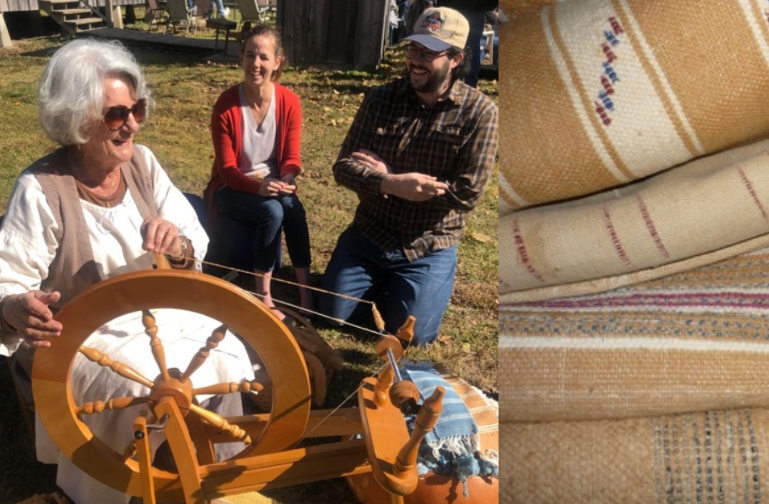This rich intertwined story of an heirloom seed, an age-old tradition, and a bright future all began when Sharon Gordon Donnan, an experienced filmmaker and textile conservator, spotted an old blanket while browsing at an antique sale in Washington, Louisiana.

It was no ordinary blanket because it was woven with natural brown cotton. Aware of naturally colored cotton through her research and travels in Northern Peru and Southern Mexico, she had never encountered a natural brown cotton blanket made in the United States. That one chance moment was Sharon’s first glimpse at the 250 year Acadian textile tradition in southwest Louisiana. The next day Sharon met Elaine Larcade Bourque, one of the last southwest Louisiana cultivators, spinners, and weavers of Acadian Brown Cotton (ABC).

Acadiana, which encompasses twenty-two parishes in southern Louisiana, is named so because approximately 3,000 Acadian refugees sought sanctuary there after being exiled from present-day Nova Scotia in the early 18th century. In the bayous and prairies of Southwest Louisiana, Acadian settlers crossed paths with short staple, naturally colored brown cotton, which scholars suggest had been brought to the area from Mexico. Soon, Acadians began to cultivate, spin, weave, and gift dowry textiles for Cajun brides, a custom that flourished well into the 20th Century. Although once integral to Acadian way of life, the tradition of using Acadian Brown Cotton had almost disappeared at the point when Sharon found the blanket.
Elaine’s accounting of the tradition and her interest in honoring the women who wove the blankets inspired Sharon to produce “Coton jaune – Acadian Brown Cotton – A Cajun Love Story” a film that documented the visual and textural quality of the blankets, and the rich human story behind it. Produced by Sharon and Suzanne Chaillot Breaux, the film premiered in 2015 in Lafayette, Louisiana and screened throughout the United States. Sharon and Elaine were invited to show the film at the Textile Society of America’s 2016 Symposium in Savannah, Georgia. There they were inspired by presentations describing small-scale sustainable cotton industries, from fields to fashion runways around the world. Modeled after the Slow Food and farm-to-table movements, these initiatives worked locally to create alternatives to the pollution and exploitation of the globalized fashion system.
Historically, Acadian Brown Cotton was a form of regional textile production that centered around the home, in many cases with Cajun women working in the fields during the day and then producing ABC blankets and textiles on handlooms at home. ABC’s naturally rich and beautiful color was a welcome addition to the Acadian color palette, one which is still appreciated today. Once harvested, it does not need to undergo bleaching and chemical dye processes, avoiding one of the textile industry’s major sources of environmental pollution today. Spurred by the documentary, Sharon and Elaine began to explore their interest in revitalizing and using this unique place-based fiber to join the fashion revolution.
In 2017, Sharon invited interested members of the community to collectively envision the revitalization of Acadian Brown Cotton, hosting a group dialogue modeled on the participatory World Café method. The time-honored traditions of family, self-sufficiency, and economic reciprocity, combined with a strong desire to maintain and revitalize the cultural heritage of Acadiana, helped individuals form the mission and vision of Field to Fashion in Acadiana and prioritized next steps.
Together, the Field to Fashion in Acadiana community outlined a mission “to preserve Acadian Brown Cotton heirloom seed, revitalize local Acadian Brown Cotton production with farmers committed to responsible cultivation and regenerative practices, [and] create a traceable supply chain for a sustainable fashion industry all within southwest Louisiana.”

With a vision of “preserving the past and creating the future,” the first focus was to preserve the ABC seed. Because so few people have grown ABC in recent years, seed banking was critical to the preservation and viability of this heirloom seed. Field to Fashion in Acadiana secured the support of the University of Louisiana Lafayette Geo-Sciences department. Dr. Durga Poudel granted permission for the Seed Bank facility to bank ABC seed donated by Elaine. ABC seed is in controlled storage in 40% humidity at 40 degrees Fahrenheit to maintain long term dormancy for future planning and successful germination.

In collaboration with Zack McMath, Acadiana Food Hub founder and president, farmers were enlisted to grow and harvest ABC in 2018. Over 12,000 seeds were banked in the first season from a small harvest, and many thousands more last season, thus ensuring the preservation of the heirloom seed.
Field to Fashion in Acadiana provides seed to farmers who make two commitments: to growing without herbicides and pesticides, and to returning a significant portion of the harvested seed to the seed bank. This reciprocity helps maintain the unique provenance of the fiber crop. Each season, more local farmers who are willing to grow and cultivate ABC via sustainable and regenerative farming practices are enlisted.
One of the participating local farmers, Bruno Sagrera of Conscious Cajun Farms found out about ABC by chance through a social media post, “I’m a Cajun and never heard of ABC so I was drawn by how much relevance this plant has to our Cajun culture and how it has mostly been lost”. He now works with Field to Fashion in Acadiana to grow and seedbank Acadian Brown Cotton.

Bruno is enthusiastic about growing ABC and knows the significance it holds for the community. “I’m just a guy who has a deep love for the land, our community, and the beautiful cultures that call south Louisiana home. I’ve decided to dedicate my life to developing regenerative farming practices best suited for the Gulf Coast and to develop a regenerative food system and economy here in Acadiana.” With successful harvests in 2018 and 2019, the 2020 season is underway.
The amount of land under cultivation has tripled, and the project has grown the number of participating farmers who represent diverse cultures in Acadiana.
Next up, Acadian Brown Cotton plans to assist ABC farmers and consumers by conducting two multi-year projects that combine research and documentation. The first focuses on seed quality and the factors that impact germination, and the second specifically evaluates lint color variation.

Demand is increasing for the Acadian Brown Cotton fiber, which has been cleaned and processed using a small-scale cotton gin. Ginned ABC has been sold to spinners and weavers across the United States and Canada, and local spinners and weavers have joined the Field to Fashion in Acadiana team, producing the first utilitarian textiles and woven works of art.
“We recognize a large workforce is required to develop a sustainable fashion industry. To accomplish this, we are partnering with Escape from Poverty, a local nonprofit, to develop a job training program” shared Deb Waldman, one of the lead organizers of the Field to Fashion effort. “Two of our team members will teach carding, spinning and weaving. Another team member has designed no waste patterns for women’s apparel.”

Since late 2017, Field to Fashion in Acadiana has been an active participant in the Fibershed Affiliate Network. The group organized under the name Acadiana Fibershed and has connected with fibersheds near and far to exchange ideas about everything from pest management practices to social media storytelling.
Field to Fashion in Acadiana recognizes their goals and scope are ambitious, yet they see how much has been accomplished in a very short time, all thanks to the dedicated and hardworking team. Francesca Anne Piccione, a sustainable textile designer and member of the group shared: “I believe the people of Louisiana will get behind our mission. We want to keep our Cajun heritage alive and honor the stories of our ancestors.”
Zack McMath of the Acadiana Food Hub noted that “this will be a unique solution for our aging farming populations and will hopefully inspire more young farmers to be responsible stewards of our unique resource, tradition, and history.”
Looking to follow along with Field to Fashion in Acadiana’s story and evolution? Visit their new landmark exhibition, Acadian Brown Cotton: The Fabric of Acadiana, which debuts September 11, 2020 at the Hilliard Art Museum, University of Louisiana at Lafayette and runs through June 30, 2021. http://www.hilliardmuseum.org/exhibits/acadian-brown-cotton-the-fabric-of-acadiana. Art history, anthropology, folklore, and economics as they tie to Acadian Brown Cotton will be explored, with historical furnishings and contemporary pieces, such as those by specialty cotton grower, spinner, weaver LaChaun Moore, on display. This exhibit is fully funded by the National Endowment for the Humanities and the Louisiana Endowment for the Humanities.





